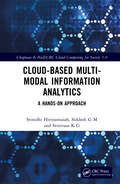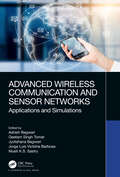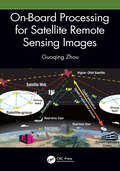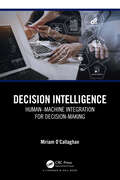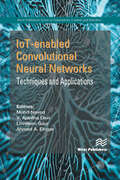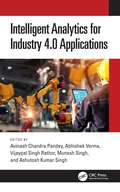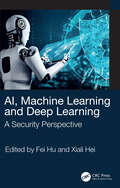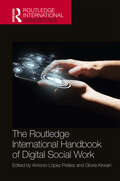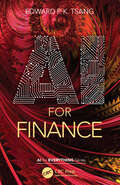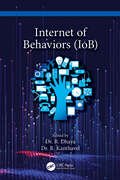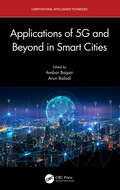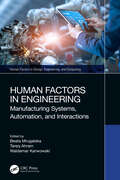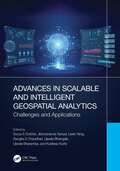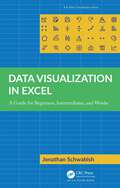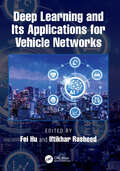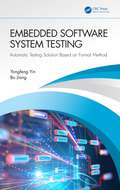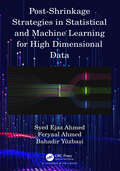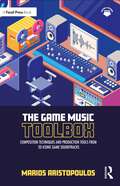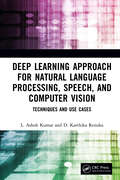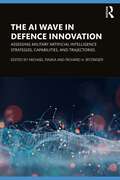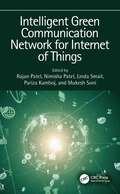- Table View
- List View
Cloud-based Multi-Modal Information Analytics: A Hands-on Approach (Chapman & Hall/CRC Cloud Computing for Society 5.0)
by Srinivasa K G Srinidhi Hiriyannaiah Siddesh G MCloud based Multi-Modal Information Analytics: A Hands-on Approach discusses the various modalities of data and provide an aggregated solution using cloud. It includes the fundamentals of neural networks, different types and how they can be used for the multi-modal information analytics. The various application areas that are image-centric and videos are also presented with deployment solutions in the cloud. Features Life cycle of the multi- modal data analytics is discussed with applications of modalities of text, image, and video. Deep Learning fundamentals and architectures covering convolutional Neural Networks, recurrremt neural networks, and types of learning for different multi-modal networks. Applications of Multi-Modal Analytics covering Text , Speech, and Image. This book is aimed at researchers in Multi-modal analytics and related areas
Advanced Wireless Communication and Sensor Networks: Applications and Simulations
by Ashish Bagwari Geetam Singh Tomar Jyotshana Bagwari Victória Barbosa, Jorge Luis Sastry, Musti K.S.This book covers wireless communication, security issues, advanced wireless sensor networks (WSNs), routing protocols of WSNs with cross-layer solutions, emerging trends in the advanced WSNs, power management, distributed sensing and data gathering techniques for WSNs, WSNs security, applications, research of advanced WSNs with simulation results, and simulation tools for WSNs. Features: Covers technologies supporting advanced wireless communication systems, sensor networks, and the conceptual development of the subject. Discusses advanced data gathering and sharing/ distributed sensing techniques with its business applicability. Includes numerous worked-out mathematical equations and formulas, as well as essential principles including figures, illustrations, algorithms, and flow charts. Provides pervasive background knowledge including both wireless communications and WSNs. Covers wireless networks as well as sensor network models in detail. This book is aimed at graduate students, researchers, and academics working in the field of computer science, wireless communication technology, and advanced WSNs.
Drawn to Life: Volume 1: The Walt Stanchfield Lectures
by Walt StanchfieldDrawn to Life is a two-volume collection of the legendary lectures of long-time Disney animator Walt Stanchfield. For over 20 years, Walt mentored a new generation of animators at the Walt Disney Studios and influenced such talented artists such as Tim Burton, Brad Bird, Glen Keane, and Andreas Deja. His writing and drawings have become must-have lessons for fine artists, film professionals, animators, and students looking for inspiration and essential training in drawing and the art of animation. Written by Walt Stanchfield (1919–2000), who began work for the Walt Disney Studios in the 1950s. His work can be seen in films such as Sleeping Beauty, The Jungle Book, 101 Dalmatians, and Peter Pan. Edited by Disney Legend and Oscar®-nominated producer Don Hahn, whose credits include the classic Beauty and the Beast, The Lion King, and Hunchback of Notre Dame.
On-Board Processing for Satellite Remote Sensing Images
by Guoqing ZhouOn-board image processing systems are used to maximize image data transmission efficiency for large volumes of data gathered by Earth observation satellites. This book explains the methods, mathematical models, and key technologies used for these systems. It introduces the background, basic concepts, and the architecture of on-board image processing, along with on-board detection of the image feature and matching, ground control point identification, on-board geometric correction, calibration, geographic registration, etc. • Describes algorithms and methodologies for on-board image processing with FPGA chips. • Migrates the traditional on-ground computing to on-board operation and the image processing is implemented on-board, not on-ground. • Introduces for the first time many key technologies and methods for on-board image processing. • Emphasizes the recent progress in image processing by using on-board FPGA chips. • Includes case studies from the author’s extensive research and experience on the topic. This book gives insights into emerging technologies for on-board processing and will benefit senior undergraduate and graduate students of remote sensing, information technology, computer science and engineering, electronic engineering, and geography, as well as researchers and professionals interested in satellite remote sensing image processing in academia, and governmental and commercial sectors.
Decision Intelligence: Human–Machine Integration for Decision-Making
by Miriam O'CallaghanRevealing the limitations of human decision-making, this book explores how Artificial Intelligence (AI) can be used to optimize decisions for improved business outcomes and efficiency, as well as looking ahead to the significant contributions Decision Intelligence (DI) can make to society and the ethical challenges it may raise. From the theories and concepts used to design autonomous intelligent agents to the technologies that power DI systems and the ways in which companies use decision-making building blocks to build DI solutions that enable businesses to democratize AI, this book presents an impressive framework to integrate artificial and human intelligence for the success of different types of business decisions. Replete with case studies on DI applications, as well as wider discussions on the social implications of the technology, Decision Intelligence: Human–Machine Integration for Decision Making appeals to both students of AI and data sciences and businesses considering DI adoption.
Creative Character Design for Games and Animation
by Jenny HarderThis book takes you through all the basic steps of character design for games and animation, from brainstorming and references to the development phase and final render. It covers a range of styles such as cartoon, stylized and semi-realistic, and explains how to differentiate between them and use them effectively. Using a step-by-step approach for each stage of the process, this book guides you through the process of creating a new character from scratch. It contains a wealth of design tips and tricks as well as checklists and worksheets for you to use in your own projects. This book covers how to work with briefs, as well as providing advice and practical strategies for working with clients and creating art as a product that can be tailored and sold. This book will be a valuable resource for all junior artists, hobby artists, and art students looking to develop and improve their character development skills for games and animation.
IoT-enabled Convolutional Neural Networks: Techniques and Applications
by Loveleen Gaur Ahmed A. Elngar Mohd Naved V. Ajantha DeviConvolutional neural networks (CNNs), a type of deep neural network that has become dominant in a variety of computer vision tasks, in recent years, CNNs have attracted interest across a variety of domains due to their high efficiency at extracting meaningful information from visual imagery. CNNs excel at a wide range of machine learning and deep learning tasks. As sensor-enabled internet of things (IoT) devices pervade every aspect of modern life, it is becoming increasingly critical to run CNN inference, a computationally intensive application, on resource-constrained devices. Through this edited volume, we aim to provide a structured presentation of CNN-enabled IoT applications in vision, speech, and natural language processing. This book discusses a variety of CNN techniques and applications, including but not limited to, IoT enabled CNN for speech denoising, a smart app for visually impaired people, disease detection, ECG signal analysis, weather monitoring, texture analysis, etc. Unlike other books on the market, this book covers the tools, techniques, and challenges associated with the implementation of CNN algorithms, computation time, and the complexity associated with reasoning and modelling various types of data. We have included CNNs' current research trends and future directions.
Intelligent Analytics for Industry 4.0 Applications
by Abhishek Verma Ashutosh Kumar Singh Avinash Chandra Pandey Vijaypal Singh Rathor Munesh SinghThe advancements in intelligent decision-making techniques have elevated the efficiency of manufacturing industries and led to the start of the Industry 4.0 era. Industry 4.0 is revolutionizing the way companies manufacture, improve, and distribute their products. Manufacturers are integrating new technologies, including the Internet of Things (IoT), cloud computing and analytics, and artificial intelligence and machine learning, into their production facilities throughout their operations. In the past few years, intelligent analytics has emerged as a solution that examines both historical and real-time data to uncover performance insights. Because the amount of data that needs analysis is growing daily, advanced technologies are necessary to collect, arrange, and analyze incoming data. This approach enables businesses to detect valuable connections and trends and make decisions that boost overall performance. In Industry 4.0, intelligent analytics has a broader scope in terms of descriptive, predictive, and prescriptive subdomains. To this end, the book will aim to review and highlight the challenges faced by intelligent analytics in Industry 4.0 and present the recent developments done to address those challenges.
AI, Machine Learning and Deep Learning: A Security Perspective
by Xiali Hei Fei HuToday, Artificial Intelligence (AI) and Machine Learning/ Deep Learning (ML/DL) have become the hottest areas in information technology. In our society, many intelligent devices rely on AI/ML/DL algorithms/tools for smart operations. Although AI/ML/DL algorithms and tools have been used in many internet applications and electronic devices, they are also vulnerable to various attacks and threats. AI parameters may be distorted by the internal attacker; the DL input samples may be polluted by adversaries; the ML model may be misled by changing the classification boundary, among many other attacks and threats. Such attacks can make AI products dangerous to use. While this discussion focuses on security issues in AI/ML/DL-based systems (i.e., securing the intelligent systems themselves), AI/ML/DL models and algorithms can actually also be used for cyber security (i.e., the use of AI to achieve security). Since AI/ML/DL security is a newly emergent field, many researchers and industry professionals cannot yet obtain a detailed, comprehensive understanding of this area. This book aims to provide a complete picture of the challenges and solutions to related security issues in various applications. It explains how different attacks can occur in advanced AI tools and the challenges of overcoming those attacks. Then, the book describes many sets of promising solutions to achieve AI security and privacy. The features of this book have seven aspects: This is the first book to explain various practical attacks and countermeasures to AI systems Both quantitative math models and practical security implementations are provided It covers both "securing the AI system itself" and "using AI to achieve security" It covers all the advanced AI attacks and threats with detailed attack models It provides multiple solution spaces to the security and privacy issues in AI tools The differences among ML and DL security and privacy issues are explained Many practical security applications are covered
The Routledge International Handbook of Digital Social Work (Routledge International Handbooks)
by Antonio López Peláez Gloria KirwanThis handbook provides an authoritative and cutting-edge overview of current research and trends related to the emerging field of digital technology and social work. This book is divided into six sections: Part 1 Reframing Social Work in a Digital SocietyPart 2 Shaping a Science of Social Work in the Digital SocietyPart 3 Digital Social Work in PracticePart 4 The Ethics of Digital Social WorkPart 5 Digital Social Work and the Digitalization of Welfare Institutions: Opportunities, Challenges and Country CasesPart 6 Digital Social Work: Future Challenges, Directions and Transformations This book, comprised of 40 specially commissioned chapters, explores the main intersections between social work theory and practice in an increasingly digitized world. Bringing a critical focus to how social work as a profession is adapting exponentially to embrace the benefits of technology, it gives specific consideration to the digitalization of the social work profession, including the ways in which social workers are using different forms of technology to provide effective services and innovative practice responses. With chapters on big data, digital archiving, e-citizenship and inclusion, gerontechnology, children and technology, and data ethics, this book will be of interest to all social work scholars, students and professionals as well as those working in science and technology studies more broadly.
AI for Finance (AI for Everything)
by Edward P. TsangFinance students and practitioners may ask: can machines learn everything? Could AI help me? Computing students or practitioners may ask: which of my skills could contribute to finance? Where in finance should I pay attention? This book aims to answer these questions. No prior knowledge is expected in AI or finance. To finance students and practitioners, this book will explain the promise of AI, as well as its limitations. It will cover knowledge representation, modelling, simulation and machine learning, explaining the principles of how they work. To computing students and practitioners, this book will introduce the financial applications in which AI has made an impact. This includes algorithmic trading, forecasting, risk analysis portfolio optimization and other less well-known areas in finance. This book trades depth for readability. It aims to help readers to decide whether to invest more time into the subject. This book contains original research. For example, it explains the impact of ignoring computation in classical economics. It explains the relationship between computing and finance and points out potential misunderstandings between economists and computer scientists. The book also introduces Directional Change and explains how this can be used.
Internet of Behaviors (IoB)
by R. Kanthavel R. DhayaThis book is intended to survey the Internet of Behavior (IoB). The book begins with the benefits and potential pitfalls of IoB. Today, IoB has huge potential in every sector of the world. There are numerous applications for IoB which benefit users as well as the business market in order to enhance the user experience. In this book, the benefits of IoB and its negative constraints are discussed in detail. It is a high time that IoB is to take its crown and ruled the world. The work of IoB is critical in keeping our data secure because it can currently identify all humans who attempt to steal someone’s data. Moreover, the business uses of IoB are in high demand. By leveraging promising technical improvements and advances in machine learning algorithms, IoB enables capture, analysis, comprehension, and response for all types of human behavior in a technique that enables the tracking and interpretation of the behavior. IoB can be very useful wherever the behavior, preferences, interests, and location of people need to be examined. On the other hand, an analytical study on consumers’ social and behavioral psychology and their influence on online purchasing is much needed. With the help of visualization tools such as Tableau and detailed reporting on selection patterns, the impact of social media on decision making and the relationship between personality and purchasing power in various age groups is found. The presented study lists major decision-making psychometric factors and highlights critical factors affecting online purchases. The role of IoB is to shape customer service through the use of artificial intelligence, cloud computing, data, smart analytics, machine learning, and other volatile technologies. The attractive components of this book are discussions of dynamic routing mechanisms to reduce energy consumption in software-defined networks; deep insight into Internet of Things (IoT) and IoB security and privacy concerns – applications and future challenges; sentiment analysis and feature reduction using an arboreal monkey compression algorithm with a deep modified neural network classifier; cybersecurity concerns for IoB; and identification of nutrients and microbial contamination in fruits and vegetables using a technology using the Internet of Behavior. There is no doubt that this book covers numerous interesting themes and details on the Internet of Behavior.
The Game Writing Guide: Get Your Dream Job and Keep It
by Anna MegillThis comprehensive guide walks readers through the entire process of getting and keeping a writing job in the games industry. It outlines exactly what a beginner needs to know about education requirements, finding opportunities, applying for roles, and acing studio interviews. Professional writers will learn how to navigate studio hierarchies, transfer roles and companies, work overseas, and keep developing their careers. Written by an experienced games writer with nearly two decades of industry knowledge, this book contains a wealth of interviews and perspectives with industry leaders, hiring managers, and developers from marginalized communities, all offering their tips and insights. Included are examples of materials such as job posts, writing samples, and portfolios, as well as chapter-end challenges for readers to directly apply the skills they have learnt. This book will be of great interest to all beginner and aspiring games writers and narrative designers, as well as more experienced writers looking to hone their skills.
Applications of 5G and Beyond in Smart Cities (Computational Intelligence Techniques)
by Ambar Bajpai and Arun BalodiThis book explores the potential of 5G technologies and beyond in smart city setups, with the availability of high bandwidths and performance, and low latency. The book starts with an introduction to 5G, along with the challenges, limitations, and research areas in future wireless communication, including the related requirements for transformation of societal paradigms and infrastructure. Applications related to visible light communication, network management in smart cities, the role of 5G in public healthcare, safety, security, and transportation, and existing and planned 6G research frameworks are included. The features of the book include: A broad perspective on 5G communications with a focus on smart cities. Discussion of artificial intelligence in future wireless communication and its applications. A systemic and comprehensive coverage of 6G technologies, challenges, and uses. The role of future wireless communications in safety, health, and transport in smart cities. Case studies of future wireless communication. This book is aimed at researchers and professionals in communications, signal processing, cyber-physical systems, and smart cities.
Human Factors in Engineering: Manufacturing Systems, Automation, and Interactions (Human Factors in Design, Engineering, and Computing)
by Waldemar Karwowski Tareq Ahram Beata MrugalskaThis book addresses aspects of human factors in engineering and provides a detailed discussion of novel approaches, systems engineering tools, artificial cognitive systems, and intelligent technologies and automation. It presents applications in diverse areas, including digital manufacturing, transportation, infrastructure development, and cybersecurity. This book: • Merges the engineering perspective with the human factors and social dimension of computing and artificial intelligence–based technologies. • Covers technological development of human factors engineering and the human dimension in applications across all areas of modern society. • Relates to human behavior in the context of technology and systems interactions. • Discusses the design and the appropriation of 3D printing techniques in the management of an innovative product system. • Presents systems engineering tools, user experience methodologies, artificial cognitive systems, intelligent technologies, and automation. The text is for students, professionals, and researchers in the fields of ergonomics, human factors, industrial engineering, and manufacturing engineering.
Advances in Scalable and Intelligent Geospatial Analytics: Challenges and Applications
by Surya S Durbha Sangita S Chaudhari Jibonananda Sanyal Lexie Yang Ujwala Bhangale Ujwala Bharambe Kuldeep KurteGeospatial data acquisition and analysis techniques have experienced tremendous growth in the last few years, providing an opportunity to solve previously unsolved environmental- and natural resource-related problems. However, a variety of challenges are encountered in processing the highly voluminous geospatial data in a scalable and efficient manner. Technological advancements in high-performance computing, computer vision, and big data analytics are enabling the processing of big geospatial data in an efficient and timely manner. Many geospatial communities have already adopted these techniques in multidisciplinary geospatial applications around the world. This book is a single source that offers a comprehensive overview of the state of the art and future developments in this domain. FEATURES Demonstrates the recent advances in geospatial analytics tools, technologies, and algorithms Provides insight and direction to the geospatial community regarding the future trends in scalable and intelligent geospatial analytics Exhibits recent geospatial applications and demonstrates innovative ways to use big geospatial data to address various domain-specific, real-world problems Recognizes the analytical and computational challenges posed and opportunities provided by the increased volume, velocity, and veracity of geospatial data This book is beneficial to graduate and postgraduate students, academicians, research scholars, working professionals, industry experts, and government research agencies working in the geospatial domain, where GIS and remote sensing are used for a variety of purposes. Readers will gain insights into the emerging trends on scalable geospatial data analytics.
Data Visualization in Excel: A Guide for Beginners, Intermediates, and Wonks (AK Peters Visualization Series)
by Jonathan SchwabishThis book closes the gap between what people think Excel can do and what they can achieve in the tool. Over the past few years, recognition of the importance of effectively visualizing data has led to an explosion of data analysis and visualization software tools. But for many people, Microsoft Excel continues to be the workhorse for their data visualization needs, not to mention the only tool that many data workers have access to. Although Excel is not a specialist data visualization platform, it does have strong capabilities. The default chart types do not need to be the limit of the tool’s data visualization capabilities, and users can extend its features by understanding some key elements and strategies. Data Visualization in Excel provides a step-by-step guide to creating more advanced and often more effective data visualizations in Excel and is the perfect guide for anyone who wants to create better, more effective, and more engaging data visualizations.
Deep Learning and Its Applications for Vehicle Networks
by Fei Hu Iftikhar RasheedDeep Learning (DL) is an effective approach for AI-based vehicular networks and can deliver a powerful set of tools for such vehicular network dynamics. In various domains of vehicular networks, DL can be used for learning-based channel estimation, traffic flow prediction, vehicle trajectory prediction, location-prediction-based scheduling and routing, intelligent network congestion control mechanism, smart load balancing and vertical handoff control, intelligent network security strategies, virtual smart and efficient resource allocation and intelligent distributed resource allocation methods. This book is based on the work from world-famous experts on the application of DL for vehicle networks. It consists of the following five parts: (I) DL for vehicle safety and security: This part covers the use of DL algorithms for vehicle safety or security. (II) DL for effective vehicle communications: Vehicle networks consist of vehicle-to-vehicle and vehicle-to-roadside communications. This part covers how Intelligent vehicle networks require a flexible selection of the best path across all vehicles, adaptive sending rate control based on bandwidth availability and timely data downloads from a roadside base-station. (III) DL for vehicle control: The myriad operations that require intelligent control for each individual vehicle are discussed in this part. This also includes emission control, which is based on the road traffic situation, the charging pile load is predicted through DL andvehicle speed adjustments based on the camera-captured image analysis. (IV) DL for information management: This part covers some intelligent information collection and understanding. We can use DL for energy-saving vehicle trajectory control based on the road traffic situation and given destination information; we can also natural language processing based on DL algorithm for automatic internet of things (IoT) search during driving. (V) Other applications. This part introduces the use of DL models for other vehicle controls. Autonomous vehicles are becoming more and more popular in society. The DL and its variants will play greater roles in cognitive vehicle communications and control. Other machine learning models such as deep reinforcement learning will also facilitate intelligent vehicle behavior understanding and adjustment. This book will become a valuable reference to your understanding of this critical field.
Embedded Software System Testing: Automatic Testing Solution Based on Formal Method
by Bo Jiang Yongfeng YinThis book introduces embedded software engineering and management methods, proposing the relevant testing theory and techniques that promise the final realization of automated testing of embedded systems.The quality and reliability of embedded systems have become a great concern, faced with the rising demands for the complexity and scale of system hardware and software. The authors propose and expound on the testing theory and techniques of embedded software systems and relevant environment construction technologies, providing effective solutions for the automated testing of embedded systems. Through analyzing typical testing examples of the complex embedded software systems, the authors verify the effectiveness of the theories, technologies and methods proposed in the book.In combining the fundamental theory and technology and practical solutions, this book will appeal to researchers and students studying computer science, software engineering, and embedded systems, as well as professionals and practitioners engaged in the development, verification, and maintenance of embedded systems in the military and civilian fields.
Post-Shrinkage Strategies in Statistical and Machine Learning for High Dimensional Data
by Syed Ejaz Ahmed Feryaal Ahmed Bahadir YüzbaşıThis book presents some post-estimation and predictions strategies for the host of useful statistical models with applications in data science. It combines statistical learning and machine learning techniques in a unique and optimal way. It is well-known that machine learning methods are subject to many issues relating to bias, and consequently the mean squared error and prediction error may explode. For this reason, we suggest shrinkage strategies to control the bias by combining a submodel selected by a penalized method with a model with many features. Further, the suggested shrinkage methodology can be successfully implemented for high dimensional data analysis. Many researchers in statistics and medical sciences work with big data. They need to analyse this data through statistical modelling. Estimating the model parameters accurately is an important part of the data analysis. This book may be a repository for developing improve estimation strategies for statisticians. This book will help researchers and practitioners for their teaching and advanced research, and is an excellent textbook for advanced undergraduate and graduate courses involving shrinkage, statistical, and machine learning. The book succinctly reveals the bias inherited in machine learning method and successfully provides tools, tricks and tips to deal with the bias issue. Expertly sheds light on the fundamental reasoning for model selection and post estimation using shrinkage and related strategies. This presentation is fundamental, because shrinkage and other methods appropriate for model selection and estimation problems and there is a growing interest in this area to fill the gap between competitive strategies. Application of these strategies to real life data set from many walks of life. Analytical results are fully corroborated by numerical work and numerous worked examples are included in each chapter with numerous graphs for data visualization. The presentation and style of the book clearly makes it accessible to a broad audience. It offers rich, concise expositions of each strategy and clearly describes how to use each estimation strategy for the problem at hand. This book emphasizes that statistics/statisticians can play a dominant role in solving Big Data problems, and will put them on the precipice of scientific discovery. The book contributes novel methodologies for HDDA and will open a door for continued research in this hot area. The practical impact of the proposed work stems from wide applications. The developed computational packages will aid in analyzing a broad range of applications in many walks of life.
The Game Music Toolbox: Composition Techniques and Production Tools from 20 Iconic Game Soundtracks
by Marios AristopoulosThe Game Music Toolbox provides readers with the tools, models, and techniques to create and expand a compositional toolbox, through a collection of 20 iconic case studies taken from different eras of game music. Discover many of the composition and production techniques behind popular music themes from games such as Cyberpunk 2077, Mario Kart 8, The Legend of Zelda, Street Fighter II, Diablo, Shadow of the Tomb Raider, The Last of Us, and many others. The Game Music Toolbox features: Exclusive interviews from industry experts Transcriptions and harmonic analyses 101 music theory introductions for beginners Career development ideas and strategies Copyright and business fundamentals An introduction to audio implementation for composers Practical takeaway tasks to equip readers with techniques for their own game music The Game Music Toolbox is crucial reading for game music composers and audio professionals of all backgrounds, as well as undergraduates looking to forge a career in the video game industry.
Deep Learning Approach for Natural Language Processing, Speech, and Computer Vision: Techniques and Use Cases
by L. Ashok Kumar D. Karthika RenukaDeep Learning Approach for Natural Language Processing, Speech, and Computer Vision provides an overview of general deep learning methodology and its applications of natural language processing (NLP), speech, and computer vision tasks. It simplifies and presents the concepts of deep learning in a comprehensive manner, with suitable, full-fledged examples of deep learning models, with an aim to bridge the gap between the theoretical and the applications using case studies with code, experiments, and supporting analysis. Features: Covers latest developments in deep learning techniques as applied to audio analysis, computer vision, and natural language processing. Introduces contemporary applications of deep learning techniques as applied to audio, textual, and visual processing. Discovers deep learning frameworks and libraries for NLP, speech, and computer vision in Python. Gives insights into using the tools and libraries in Python for real-world applications. Provides easily accessible tutorials and real-world case studies with code to provide hands-on experience. This book is aimed at researchers and graduate students in computer engineering, image, speech, and text processing.
The AI Wave in Defence Innovation: Assessing Military Artificial Intelligence Strategies, Capabilities, and Trajectories
by Michael RaskaAn international and interdisciplinary perspective on the adoption and governance of artificial intelligence (AI) and machine learning (ML) in defence and military innovation by major and middle powers. Advancements in AI and ML pose pressing questions related to evolving conceptions of military power, compliance with international humanitarian law, peace promotion, strategic stability, arms control, future operational environments, and technology races. To navigate the breadth of this AI and international security agenda, the contributors to this book include experts on AI, technology governance, and defence innovation to assess military AI strategic perspectives from major and middle AI powers alike. These include views of how the United States, China, Japan, South Korea, the European Union, and Russia see AI/ML as a technology with the potential to reshape military affairs and power structures in the broader international system. This diverse set of views aims to help elucidate key similarities and differences between AI powers in the evolving strategic context. A valuable read for scholars of security studies, public policy, and STS studies with an interest in the impacts of AI and ML technologies.
Intelligent Green Communication Network for Internet of Things
by Rajan Patel Nimisha Patel Linda Smail Pariza Kamboj Mukesh SoniThe text covers the advanced and innovative concept of green communication networks using the Internet of Things in different fields including cloud technology, agriculture, the automobile sector, and robotics. It will also help readers in learning the efficient use of sensors and devices in the Internet of Things networks. The text covers 5G communication and its application for intelligent and green network-enabled Internet of Things. This book • Discusses intelligent and green networking-enabled Internet of Things • Covers architectures and models for intelligent and green communication networks-enabled Internet of Things • Discusses designing Internet of Things devices that help in reducing the emissions of CO2 in the environment and energy consumption • Highlights green computing approach and green communication network designs and implementations for Internet of Things ecosystem • Includes studies on energy-aware systems, technologies, and green communication This book comprehensively discusses recent advances and applications in the area of green Internet of Things communication in a single volume. It will serve as an ideal reference text for senior undergraduate and graduate students, and academic researchers in the fields of electrical engineering, electronics and communication engineering, computer engineering, and information technology. .
A Software Development Approach for Driving Competitiveness in Small Firms
by Delroy CheversThe COVID-19 Pandemic has forced many businesses to accelerate their digital transformation strategies to continue to meet the changing needs of their customers. This has resulted in significant growth in the global software market. However, for decades, managing software product quality has been a major challenge for many software development firms. This low success rate is due mainly to the development and delivery of low-quality software products. In addition to the direct costs associated with poor-quality software, software flaws can also raisesecurity concerns, as hackers can gain complete control of various devices and data, such as mobile phones, computers, or the operational transactions of businesses. These security and privacy breaches are currently occurring with great frequency. Although producers and consumers of software products spend vast amounts of money developing and purchasing these products, in many cases the promised benefits of user satisfaction, efficiency, productivity and profitability are not realized. In more severe circumstances, software development firms have failed and face the threat of going bankrupt, being acquired or suffering closure, because customers are demanding high-quality software products that they consistently fail to deliver. Small and medium enterprises (SMEs) operating within the software development industry have a more critical need to produce high-quality software since they are less able to absorb both the cost and the reputational impact of producing low-quality output. A Software Development Approach for Driving Competitiveness in Small Firms provides some cost-efficient options that can help SMEs increase the likelihood that their software will be of high quality. It tells the story of the entrepreneurial journey that small firms should take to deliver high-quality software products. By utilizing practical examples and providing several recommended solutions to decrease the likelihood of producing low-quality software, the book outlines how mobilizing people, processes and technology are integral to the software development process and emphasizes why process maturity is the most influential factor in software development in small and medium enterprises.
